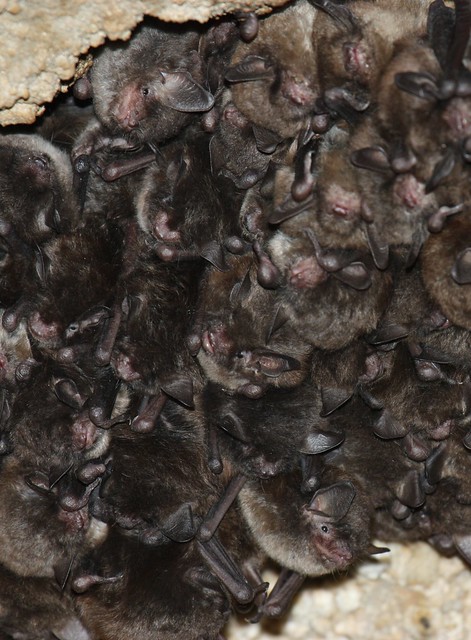Proper safeguarding and stewardship of our flora has the very intended effect of also benefiting our fauna. Just like humans, animals depend on plants for things like food and shelter. And plants often rely on animals for pollination and seed dispersal. Protecting plant habitats allows these beneficial relationships to occur as nature intended. Monarch butterflies need milkweed, and bats need trees.
Shaw Nature Reserve is an ideal habitat for bats. It has plenty of mature trees with nooks, crannies, and hollows for roosting females. The streams, wetlands, and Meramec River are a readily available water source. And there are plenty of insects to eat.
Missouri-native bats are insectivores, which is one of the reasons they are so important to our ecosystem. These flying mammals eat everything from mosquitoes to moths, keeping insect populations in check. The Nature Reserve boasts an impressive diversity of bat species, which we now know more about thanks to a single encounter.
In 2017, the Nature Reserve hosted the Academy of Science–St. Louis Bioblitz. For two days, participants combed the area looking for as many plant and animal species as they could find.
A single Indiana bat (Myotis sodalis) was captured during an evening session along Brush Creek. The Indiana bat is federally endangered, and had never been documented at the Nature Reserve before that night.
Wildheart Ecology, which carried out the Bioblitz bat survey, made plans to dive deeper into the bat biodiversity of the Nature Reserve. In the summer of 2018, researchers Vona Kuczynska and Jennifer Mullikin placed a series of acoustic detectors around the Nature Reserve, capturing unique audio signatures for each bat species.

The data revealed the presence of nine different species, including the Indiana bat, the endangered gray bat (Myotis grisescens), and several other species of conservation concern. Because some bats are migratory, it is possible even more species call the Nature Reserve home throughout the year.
“These findings that Shaw Nature Reserve provides critical habitat for these federally endangered bats highlight the importance of the natural communities for which we are stewards,” says Dr. Quinn Long, Director of Shaw Nature Reserve.

In 2019, the U.S. Fish and Wildlife Service carried out mist netting at the Nature Reserve in hopes of gathering even more information about the bats that live there. Large nets were set up in areas where bats might go to feed. Bats flew into the nets; researchers removed them and recorded data such as species, sex, and weight; then the bats were released back into the night sky.
Within minutes of opening the nets, bats were being captured for processing. The first Indiana bat captured that night was the exact same bat from the BioBlitz nearly two years earlier, noted by a Missouri Department of Conservation band placed on its wing. Researchers placed a transmitter on the bat—given the name Celeste—and three others in order to track them to their roost.





With the help of Nature Reserve staff, the roost was located in a burned-out tree near the Meramec River. The area is a perfect example of the natural and man-made forces at work to create this bat habitat. Two major floods along the Meramec in recent years deposited large amounts of driftwood in the woodland near the river. Nature Reserve staff treated the area with prescribed burning in 2017 at a time when all that extra wood fuel was dry from drought—creating intense flames that killed off more than a dozen trees. It’s one of these trees, a charred silver maple, that two years later served as an enticing roost for Indiana bats.
To learn more about how you can support ecological restoration at Shaw Nature Reserve, contact restoration@mobot.org.
Researchers returned to the tree several nights at dusk to watch the bats emerge from beneath the bark. Detailed counts revealed more than 150 Indiana bats living in this single tree, making it one of the largest known summer roosting sites for this species in Missouri.
After spending summer at the Nature Reserve, the bats will head for their winter homes. But as we learned from Celeste, they are likely to return again next year. Maybe not to the same tree, but because of excellent ecological management, they should have plenty of options to choose from.

Bats Under Threat
Bat populations across the United States face many threats including habitat loss, pesticide use, even wind turbines. But one of the biggest threats comes from a devastating disease known as white nose syndrome. The fatal disease is caused by a fungus that grows on hibernating bats, often appearing as a white fuzz on the face and wings.
First appearing in the U.S. in 2006, it reached the St. Louis area in 2012, killing millions of bats along the way. Of the nine species documented at Shaw Nature Reserve, at least six are threatened by the spread of this disease. You can help prevent the spread of white nose syndrome by avoiding caves used by hibernating bats and generally leaving these animals alone.

Cassidy Moody — Senior Digital Media Specialist

Leave a Reply